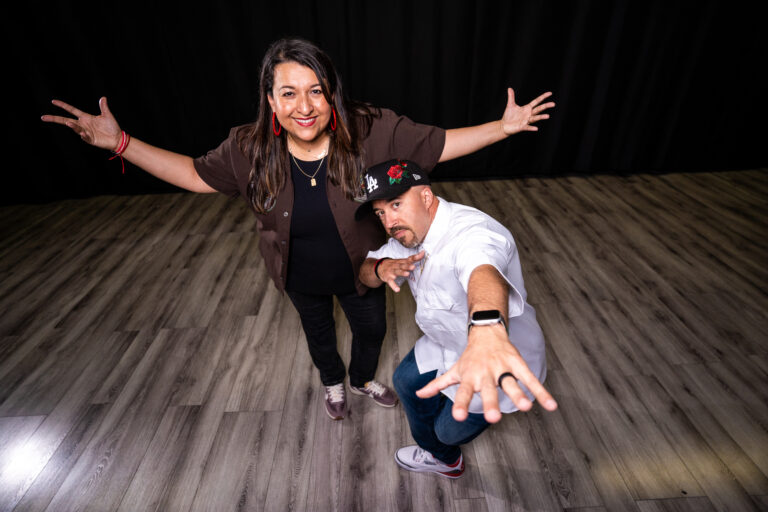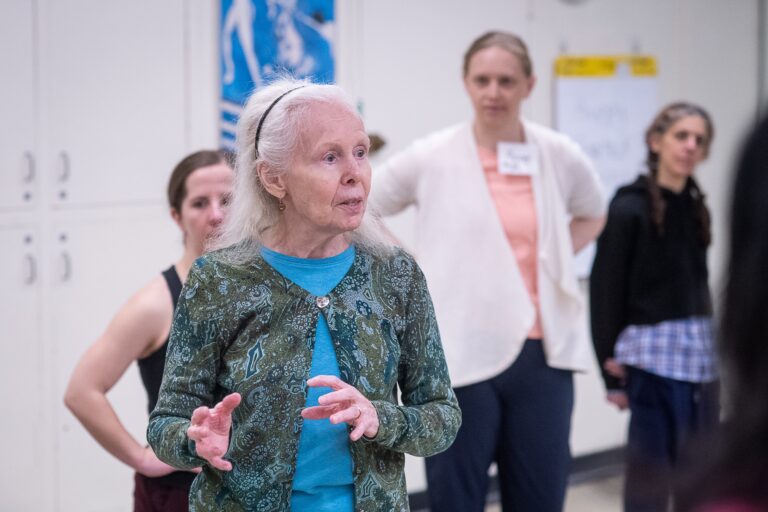Before Jason Samuels Smith became the tap master and international star he is today, more than one person wanted to punch him in the face. He was one of the best tap dancers in the country at an incredibly young age. But with fame had come a sense of entitlement, and he wasn’t afraid to put another tapper in his place by humiliating him in a tap jam. There were times, in fact, when his antagonistic personality offended people so deeply that they wanted to fight him afterward. “I was egotistical with my style, very aggressive,” recalls Samuels Smith, who used to be nicknamed “Iron” because he broke so many taps. “I felt like I was in a circle that very few people were welcome into, and like I had to police it in some way. I thought I was doing the right thing, but I was actually pushing more people away than bringing them to me.”
Somewhere along the line, he changed. He can’t pinpoint the exact moment, but around age 20 and the turn of the millennium, he realized that if other dancers actually wanted to fight him, then they cared about tap as much as he did. And if they were undertrained, it was more honorable to help rather than ridicule them. Practically overnight, Samuels Smith went from being an unapproachable virtuoso to an educator. “If I’m judging people based on their learning curve or their vocabulary or knowledge, then I need to at least contribute to the community in a positive way,” he remembers thinking. “I started teaching more, going to more workshops and festivals and producing shows.” Almost immediately, unsolicited work offers started rolling in. But teaching didn’t just expand his career opportunities; it also allowed him to become a better person, to realize his full potential and to contribute to the tap community at large.
Still an aggressive tapper, Samuels Smith, now 27, is polite, confident and driven, a grown-up version of his adolescent, arrogant self. His dancing has matured, too, showing subtlety and nuance where once there was only heaviness and volume. He’s comfortable in his own skin. “I try to tell stories and show relationships with melody and harmony, dynamics and shading,” he says. “My style is about elevating and making statements in my art. I think that when you do things with a certain force and energy some people can understand them more, but there’s a lot that can be said by being light. I think that if you can balance out that force, you can speak from all perspectives.”
The Making of a Master
Dance is something Samuels Smith couldn’t have escaped if he’d tried. His mom, Sue Samuels, teaches jazz at Broadway Dance Center in New York City, while his father, JoJo Smith, was a professional jazz dancer. Older sister Elka is also a trained tap dancer, as well as co-creator of Divine Rhythm Productions, the first talent agency to focus on tap. Even Debbie Allen is a relative: They’re second cousins.
Discovered at age 7 by Savion Glover during class at BDC, Samuels Smith got his big break at age 15 with a role on “Sesame Street,” where he worked alongside both Glover and Gregory Hines. The experience changed his life and convinced him that it was possible to have fun and make money at the same time. Soon after, Samuels Smith joined the Broadway cast of Glover’s Bring in ’Da Noise, Bring in ’Da Funk and eventually became the youngest dancer to perform the lead role.
Samuels Smith hasn’t lost momentum since. The year 2003 was particularly big. His first achievement was coordinating the inaugural L.A. Tap Festival, which he co-developed with Allen and co-directed with girlfriend and fellow tap dancer Chloe Arnold. The event, celebrating its sixth anniversary in August, was designed to unify tappers of different genres, generations and nationalities. So it was a particularly devastating blow when Hines passed away on the first day. Realizing the importance of soldiering on—and showing respect for the very legend who had first inspired him to try tap—Samuels Smith turned the festival into a tribute. That same year, he choreographed the opening number of the “Jerry Lewis Telethon,” for which he earned both an Emmy and an American Choreography Award for outstanding choreography, and he co-starred with Arthur Duncan in an independent film called Tap Heat.
Recently, he has been creatively evolving through his work with Indian dance guru Chitresh Dash, 63, whom he met at the American Dance Festival. Since 2005, they’ve been traveling the world performing Indian Jazz Suites, a collaborative show in which they perform individually and together. “We’re not creating a fusion,” explains Samuels Smith. “We do different time signatures and different phrases and improvise back and forth. When I first met him, I felt like an idiot in some of those rehearsals—he was breaking down a lot of what I knew musically and technically. He inspired me to change my style, and I can see that I’ve been influencing him as well.” While they’ve toured twice to India and three times across the U.S., the show has yet to appear in NYC, a goal for this year.
Samuels Smith also starred in 2006’s Imagine Tap, directed and choreographed by Derick Grant in Chicago and co-starring fellow tap stars such as Ayodele Casel, Bril Barrett and Joseph Wiggan. It was an experience that inspired him to begin developing his own production, Charlie’s Angels, which he’s creating, choreographing, directing and starring in alongside Arnold, Dormeshia Sumbrey-Edwards and Michelle Dorrance. The show, which he workshopped in NYC last year and hopes to re-create on a larger scale, is designed to give female tappers recognition he feels is long overdue. “I’m so happy for the chance to help bring women to the forefront and show the power they have,” he says. “I feel like women are underappreciated because they’re women, and I think people judge the book by its cover and don’t realize how deep the information goes.”
Samuels Smith’s greater focus, of course, is on getting all tap dancers—female and male—the representation and recognition they have sorely been lacking. He talks passionately about how he and his peers still struggle for respect—and jobs—in this country, and about how he’d like to lead his generation in making all elements of tap accessible. In addition to producing shows and designing a shoe line (this summer will see the debut of the Jason Samuels Smith Tap Shoe by Bloch), he also hopes to create instructional videos and open dance studios, all while maintaining the integrity and substance of the art.
“I want to take advantage of our talents and abilities, because the truth is, somebody’s going to try and take advantage of us,” Samuels Smith says. “So if we do it first, we beat them to the punch and we also control our own destiny. If we do it like that, then we become unstoppable.”
An Oral Tradition
Passing on tap’s heritage is a responsibility Samuels Smith feels deeply. “Anybody who assumes the title of tap dancer is an ambassador for the art and has the responsibility to continue the tradition of his teacher, and his teacher’s teacher, in a dignified, sophisticated way,” he says. This means not only teaching steps, he explains, but showing film clips of tap legends and telling stories about his own teachers, which he does during his classes at workshops and festivals around the world.
Seeking out as many living masters as possible is also key to ensuring the artform’s longevity. “Our tradition is so oral that not a lot has been properly documented,” Samuels Smith says. “You can’t necessarily go to reference books. You have to go to masters of the art to find the answers, and you have to go to more than one because they have conflicting stories.”
The improvisational, community-oriented spirit of tap is alive in his own teaching style. “I don’t know what I’m going to teach until I get there and feel out the class,” he says. His one consistency is the same warm-up, based on that of legendary tapper Steve Condos: “I’ve taken his teachings and embellished them—changed things here and there, added things.” Samuels Smith’s classes are also known to feature steps that he himself feels the need to practice. “I will teach something I need to work on myself in class, and that way we’re all practicing and learning together,” he explains.
He takes his role as educator so seriously that he has no qualms about asking disrespectful students to leave the classroom. On his list of pet peeves? Dancers who talk in class, don’t listen to instructions or practice whatever step they feel like. “Part of learning how to be a tap dancer is patience and timing, knowing when to dance and when not to dance, when to speak and when to listen,” he explains. “Listening is the key to developing and growing as a tap dancer, and if dancers are unwilling to listen, then it’s very difficult to educate them.”
At the same time, he says, there are too many teachers who turn students off because they are unforgiving, inflexible or stubborn: “It’s important to have patience and the understanding that everybody is at a different level and a different stage in their dance career and life. If you can begin to have that understanding as a teacher, then I think students will have more of a willingness to learn and listen.”
For Samuels Smith, the communication that happens between teacher and student is at the very heart of tap dance. It’s how every generation of tap dancers has not only kept the tradition alive, but expanded and added to it. “Tap encompasses so many different things—music, the political issues of the times, emotions, the human element,” he says. “Tap is so much about individual identity that if you don’t tell your own story, and the story of those who passed it down to you, then what do you say?”
Sara Jarrett is a writer based in New York City.
Photo by Jayme Thornton



